Here you can find - buy the book: "Green Pages" Pleshakov
A. A. Manual for students of educational organizations / Moscow. Publisher: Enlightenment. (Green House) - 224 pages. : il. - ISBN 978-5-09-032015-3 - 978-5-09-030054-4. Created on 05.20.2016
The textbook "Green Pages" was created in accordance with the Federal State requirements of the standards of general primary education of the 2nd generation.
White hare and European hare, similarities and differences.
Their common similarities: night animals, resting during the day - feeding at night, burrowing in the snow in the winter, burying the trail, gray in the summer,
Differences species:
Habitat.
Color in winter.
Type of feed.
Paw prints.
White hare.
White, the tips of the ears are black.
Thin twigs.
Wider, and jumps shorter.
Hare-hare.
Light gray.
Dry grass.
Cunning confuses his mark, often makes "loops".
Story: "His Majesty the Boletus".
The story about mushrooms from the book "Green Pages", according to the program 3 classes.
Annotation: Story: "". A cut mushroom - a boletus brings joy, respect, admiration to mushroom pickers ... They are proud of such finds, hold them in their hands for a long time, do not rush to put them in the basket - they will recount. The mushroom looks stately, a real “king of mushrooms”, and sometimes, it is called for its pompous appearance, “colonel”. And, it is not difficult to guess why, the housewives call it white: in the soup, and in the pan, it is always white.
Questions to the story: "His Majesty the boletus".
- What feelings does the mushroom cause in the author - "His Majesty Borovik"? (Joy, respect, admiration).
- How many mushrooms - borovik collected, familiar to the author, per day? (86 mushrooms).
- What color is boletus mushroom? (hat - brown, leg - not quite white).
- Why mushroom boletus called white? (In any form, white perishing: dried, boiled, fried - always remains white).
- What color is the brown mushroom - dried? (The black).
- Why, white mushroom called boletus? (Occurs in pine forest).
- What does a mushroom boletus look like? (The hat is reddish-brown, the leg is thick. It looks important, it is puffy).
- What kind of white fungus does the author describe in the story? (Pine, oak, fir, birch).
- How many varieties of white fungus do scientists have? (About two dozen).
- What is the difference between white mushrooms of different varieties? (the color of the cap and the meeting place).
- What is popularly called white mushroom? ("The king of mushrooms", "colonel").
- Why in the story the author calls the mushroom boletus super mushroom? (He embodied all the mushroom beauty and strength).
Story: "Yarrow".
Annotation: Story: " Yarrow"from the book:" Green Pages 3 class. "Each leaf of the yarrow is cut into many slices and cannot be counted. Many flowers from inflorescences form up to 25 thousand seeds. It reproduces not only by seed, but also by rhizome. It can be found in meadows, on the side of roads, on the forest edge. The plant has many medicinal properties. Thousands of leaves stop bleeding well and heal wounds, they are used even for toothache. Its preparations are prescribed for diseases of the intestine, stomach and improve appetite.
Annotation: Story: "Similar, but different" from the book: "Green Pages 3 class." Do not confuse toads with frogs, and frogs with toads. They are similar, but different.
Similarities:
- The same time is spent on land and in water.
- Breed in water.
- Begin to develop with the eggs.
- Appear tadpoles, which then turn into a frog or a toad.
- The skin is bare.
- They feed on insects.
- The similarity in appearance and habits.
Differences:
- The eggs are different.
- The body of toad tadpoles is flattened out, and the head is elongated.
- The skin of frogs is smooth, moist and tender. In toads it is hilly and rough.
- Skin secretions in frogs are almost non-poisonous, and in frogs for animals they are poisonous and smell unpleasant.
- Frogs are more agile than toads.
- The tongue of the toads is shorter than the frog.
- Toads do not have toads, and frogs have them.
- Frogs hunt night and day, frogs - at night.
A story about beavers.
Stories from the book "Green Pages" about beavers, according to the program 4 classes. The book includes eight stories.
Annotation "Green pages. The story about beavers": The royal beaver looks majestically. No wonder he is called the" king of rodents. "He is surprised by his teeth, fur coat and tail. He surpassed all animals in the building art. Not one beast is not able to build such grandiose buildings - dams. Any trees to him obedient, from osinki to oak, of any thickness. Fells them with the help of powerful teeth - incisors, like a woodcutter - with a saw and an ax, crushing a fallen tree into the parts he needs.
Very handsome, flaunt, all year round, in his luxurious fur coat, which allows, for a long time, to spend under water. The fur of the fur coat is thick, it does not let the water through, therefore, coming out of the water, having shaken itself, the animal dries quickly.
And, the beaver's tail is unusual, looks like a shovel: naked, covered with scales. Helps the owner and during swimming, and during work. Resting against the ground with the tail, the beaver gnaws the tree.
This tutorial will be useful in the knowledge of the world, adults and children. The content of the book: "Green Pages. Pleshakov A. А., consists of twenty four pages.
Page 1st. , talks about the grass around our house and on the street.
- Bird buckwheat.
- From the life of a dandelion.
- Yarrow
- Sour but tasty.
- Burdock, he's burdock.
- The most bitter grass.
- Green traveler.
- Resident of vacant lots.
- Make friends with nettles.
Page 2nd, where we are talking about the first flowers that meet the spring.
- The most courageous.
- Giving honey
- Hurried crested hen.
- Anemone.
- Cheerful, fresh, washed.
- Goose bow
- Grass, evoking dreams.
- Keys to summer
Page 3, about rare and endangered plants, written with the hope that flowers will always bloom on earth. Nature conservation is our common cause.
Page 4th is about trees.
- About birch and birch sap.
- Strength and weakness of the oak.
- Tree-citizen.
- Bold tree.
Page 5th, whose heroes are mosses.
- Below the grass.
- From the Arctic to Antarctica.
- Where does the moss begin
- Live sponge.
- Kukushkin flax, ostrich feather and others.
Page 6th - about mushrooms.
- Not plants and not animals.
- Why mushrooms in the forest.
- Wolf tobacco, hare potatoes.
- Going for mushrooms.
Page 7th, almost fabulous, invites you to lichens.
- Costume forest king.
- Nakipny, leafy, bushy.
- Union of fungus and algae.
- Reindeer moss.
- Long-livers
- Lichens leave the city.
Page 8th. Events that occur in the web kingdom.
Page 9 is about complex relationships between insects and humans.
Page 10 is about dragonflies.
- Just.
- Big-eyed hunters.
- Life is under water.
- Dragonflies are waiting for help. Read online.
Page 11th, whose heroes are the golden eyes, and they are flyrnits.
- First meeting.
- Egg on a thin stalk.
- "Tliny lions" and running pupa.
- Defenseless beauties.
Page 12 about beetles.
- Who more than anyone in the world.
- May beetle and its relatives.
- Beetle on the road.
- Talking beetle.
- Six-legged deer.
- Big water fan.
- Without them, the earth would be bored.
Page 13th, which tells almost detective stories - about a dangerous criminal among insects.
- Verbal portrait.
- His first "case".
- He goes beyond all boundaries.
- He changes clothes.
- He is hiding.
- Who will win?
Page 14th, which tells about the extraordinary life of a ladybug.
- "Sun".
- Name on the wings.
- Three life ladybug.
- Deceptive appearance.
- Migratory ... bugs.
- Where cows overwinter.
- Trouble
Page 15th, the brightest and most colorful, because it tells
about butterflies.
- 140 thousand species.
- Pollen on colorful wings.
- How many legs does a caterpillar have?
- Unusual duty.
- Admiral's dangerous life.
- Bluebird in an anthill.
- Mysterious hawk moths.
- Dimming rainbow.
Page 16th, which tells how insects overwinter.
Page 17th, the heroes of which are the first insects to wake up, and the time of action is early spring.
- The first butterflies. - read online
- Hooray! Woke up the flies!
- Take care of the bumblebees!
- Ants who remember everything.
Page 18, about toads and frogs, which many do not like.
- Their trouble is our fault.
- What are frogs and toads.
- Link in an unbroken chain.
Page 19th. Summer has gone - about the life of birds in the fall.
- How and when?
- And who remains!
- Help the birds!
Page 20th - about the birds that will stay with us in the winter.
- Klysty.
- Tap dance
- Bullfinch.
- Woodpeckers
- Pitch.
- The little king.
Page 21 is about birds in spring.
- Starlings flew.
- Singing in the blue sky.
- "Roscherk" chaffinch.
- Song thrush.
- Pied Flycatcher.
- Invisible
Page 22nd, which tells about the winter life of animals.
- City under the snow.
- Nimble predators.
- Three hundred cones for lunch.
- Fox hunting.
- About boar and moose.
Page 23rd, the most mysterious, her heroes - bats.
- What the legends say.
- What science says.
- Caught echo.
- Forest ambulance.
- Like birds and with birds.
- Do not hurt winged animals!
Page 24th, tells about obrah.
- Beaver - "King of Rodents".
- Miracle first - beaver teeth.
- Miracle second - beaver coat.
- The third miracle is the beaver tail.
- The fourth and fifth miracles are beaver huts and dams.
- The sixth miracle - beavers.
- One hundred squirrels for beaver.
- The seventh wonder - the beavers are back!
How many pages in the Book of Nature.
With this book you will learn about the most daring flowers, the first to meet spring, you will meet with ants, butterflies and ladybugs, you will understand what the strength and bravery of the oak tree, get into the kingdom of mushrooms and lichens, penetrate into the secrets of bats, get acquainted with life " King of Rodents "- beaver. This book is for younger students, but it will be interesting to both parents and teachers, who together with the child will want to meet with the unique world of wildlife.
Some tasks from the workbook " The world“according to the program of A.Pleshakov“ The world around us ”from the 1st to the 4th grade is difficult to accomplish without this manual. It is good to prepare reports on it. It goes together with A.A. Pleshakov“ Atlas of the determinant “From earth to sky”. Handbook for students of educational institutions of the GEF.
Green pages of the book of nature-10
Page one, which tells about the grass at our house-11
Bird buckwheat
From the life of dandelions
Yarrow
Sour but tasty
Burdock, he's burdock
The most bitter grass
Green traveler
Wasteland resident
Make friends with nettles
The second page, where we are talking about the first flowers that meet spring- 25
The bravest
Giving honey
Hurried crested
Anemone
Cheerful, fresh, washed
Goose bow
Grass casting dreams
Keys to summer
Page three, written with the hope that flowers will always bloom on earth - 37
Page four - about trees - 42
About birch and birch sap
Strength and weakness of oak
City tree
Bold tree
Page five, the heroes of which are mochi 52
Below the grass
From the Arctic to Antarctica
Where does the moss begin
Live sponge
Kukushkin flax, ostrich feather and others
Page six - about mushrooms -60
Not plants or animals
Why should mushrooms in the forest
His Majesty Borovik
Insidious doubles
Wolf tobacco, hare potatoes
Going for mushrooms
Page seventh, almost fabulous, which invites you to lichens-69
Costume forest king
Nakipny, leafy, bushy
Union of fungus and algae
Reindeer moss
Long-livers
Lichens are leaving the city
Page Eight, the events of which take place in the spider kingdom - 80
Page Nine, on the complex relationship of man and insects -85
Page ten - about dragonflies - 90 Just like that
Big-eyed hunters
Life under water
Dragonflies waiting for help
Page eleven, whose heroes are the golden-eyed, they are flornitsy - 97
First meeting
Egg on a thin stalk
"Lions" and running pupa
Defenseless beauties
Page Twelve - about beetles - 104
Who more than anyone in the world
May beetle and its relatives
Beetle on the road
Talking beetle
Six-legged deer
Big water lover
Without them, the earth would be bored
Page thirteen, almost detective - about a dangerous criminal among insects-117
Verbal portrait
His first "case"
He crosses all boundaries
He changes clothes
He is hiding
Who will win?
Page fourteen, where we are talking about the extraordinary life of an ordinary ladybug - 124
"Sun"
Name on the wings
Three Life Ladybird
Deceptive appearance
Migratory. beetles
Where cows overwinter
Trouble
Page fifteen, the most colorful, because it tells about butterflies- 134
140 thousand species
Pollen on motley wings
How many legs does a caterpillar have?
Unusual Duty
Admiral's Dangerous Life
Bluebird in an anthill
Mysterious hawk moths
Dim Rainbow
Page sixteenth, which tells how insects hibernate- 146
Page seventeen, the heroes of which are insects, and the time of action is spring - 150
First butterflies
Hooray! Woke up the flies!
Take care of the bumblebees!
Ants that everyone remembers
Page Eighteenth, about frogs and toads, which many do not like at all - 157
Their trouble is our fault
What are frogs and toads
Similar but different
Link in the indissoluble chain
Page nineteenth, about the life of birds in the fall -165
FEBRUARY 2016
Close a window

Once in the middle of July, in the country, we walked with dogs along an ugly, plastic fence. The road was covered with prickly gravel, and it was painful to walk, even in slippers. Nasty gravel wounded and dog paws. Everything was boring.
And suddenly ... a huge yellow butterfly flew past us and sat in the middle of the road - it was attracted by stones heated in the sun. My heart beat with excitement - it was MAKHAON! I have never seen swallowtails here, although I take lots of butterflies.
Makhaon felt my interest in him and began to tease: he would pose, he would fly up to the next stone, the dogs would rush to him, and he would fly away - in general, the picture was not the best.
Therefore, I will give a description of the Machaon from the book “Other Shores” by the remarkable writer Vladimir Nabokov: “On the Persian lilac at the veranda of the outhouse I saw my first Machaon ... fawn spurs dangling from a tilted raspberry-purple cluster and, reveling in it, all the time frantically flapping their huge wings. ”
Butterflies are a real miracle given to us by nature.
But attention, nature lovers! Hurry to capture this miracle, because in Europe, in those places where toxic chemicals are used in the fields, there are NO butterflies! Now, however, in many countries began to abandon chemistry, and butterflies reappear in the meadows.
And we still have a huge variety of butterflies: day and night, and the farther from the city, the more rare butterflies!
And most importantly - don't catch and kill them. All these boxes with pinned, dried butterflies are disgusting. They look like plastic flowers, fruit from wax, landscapes painted on stone walls ...
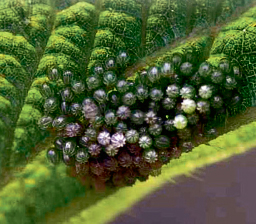
Let the nature around us be alive and beautiful!
And how much the same butterfly still harbors unsolved mysteries of nature! During their life, butterflies go through four transformations - a metamorphosis. The transition from one stage (egg) to another (caterpillar) is called metamorphosis. Four complete metamorphosis: an egg, a caterpillar, a pupa, and an adult (butterfly). Every new transformation in butterflies is complete - the pupa is completely different from the butterfly!
Testicles - This is the first phase of development. The butterflies take great care of them, fill the testicles with secretions of glands hardening in the air, and they produce capsules that are usually masked by the color of the surface (plant leaf, tree bark).
The next period is teenage, and from the eggs the larvae appear - caterpillars. They actively feed, grow rapidly, increasing body weight (sometimes tenfold!), And accumulate fat for the following transformations. The caterpillars have a gnawing mouth apparatus and feed on the leaves of plants. Often in the name of the butterfly is indicated the food preference of its caterpillar, for example: urticaria, burdock, cabbage soup. Sometimes the plant is indicated in the adjective: poplar lentochnik, willow peribus.
Each caterpillar has three pairs of jointed legs with claws and several (up to five pairs) false legs with bundles of claws, which allows it to cling to any surface. The caterpillars are very diverse in color and appearance, and some of them - bright green, red, yellow with colored touches - are just amazing! The bright color of the caterpillars often indicates: “Don't touch me, I'm poisonous!” The brown and green colors help the caterpillar to hide better, because it is very tasty for birds. Sometimes caterpillars look exceptionally nasty, for example caterpillars of urticaria or peacock eyes. Probably, many of you have seen in the summer, in the country, clinging to the nettles black-striped caterpillars in black setae. And if you look at them under a microscope - then these are creatures from horror movies! But this is also a protective disguise!
During the last molt, the caterpillar turns into dolly. The pupae are very cute and varied in color and shape. They do not eat, do not move, and usually hang, attached to branches, or lie loose on the ground, among the fallen leaves.
The day before the birth through the shell of the pupa it is already possible to consider the coloring of the wings of the future beauty of the butterfly. And if you're lucky, you can see how a butterfly hatches from a pupa, slowly turning folded wings - this is an amazing sight!
The pattern and color of the butterfly's open wings is completely different than the underside coloring. This is also a protective mechanism: folding the wings, the butterfly merges with the texture of the tree or sheet and becomes invisible to predators. And what a butterfly carved and lacy edge of the wings!
The butterflies themselves feed on the nectar of flowers, and at the dacha I specifically grow onions, oregano, Persian lilacs and Sedum - my favorite melliferous butterflies.
The adult summer butterfly lives from several days to several weeks. Autumn butterflies remain to winter and can live more than ten months. Some butterflies fly five thousand kilometers! It was such a swallowtail we saw on our way.
And one fall, I brought thinned cabbages grown by me into the city. And, apparently, with them came the well-fed caterpillars of cabbage-butterflies. They crawled out, pupated and, clinging to the wall behind the refrigerator, hung there until the sixth of January. And imagine my amazement when at Christmas three white butterflies suddenly fluttered in my kitchen! Just miniature angels! Alas, their life was short: cold, boring, nothing to eat, although I put drops of honey and jam with syrup on the window sill, but they fluttered and fell asleep forever on indoor flowers. Unfortunately, I was not ready for their appearance.
Presentation “Ordinary ladybug»Green pages. Pleshakov A.A. Completed: Completed: primary teacher primary school teacher of the Kuzmin classes classes of the Kuzmino-Gatiev secondary school of the Tambov Gatiev secondary school of the Tambov region, Tambov district, Tambov district Elena Anatolievna Troshkina

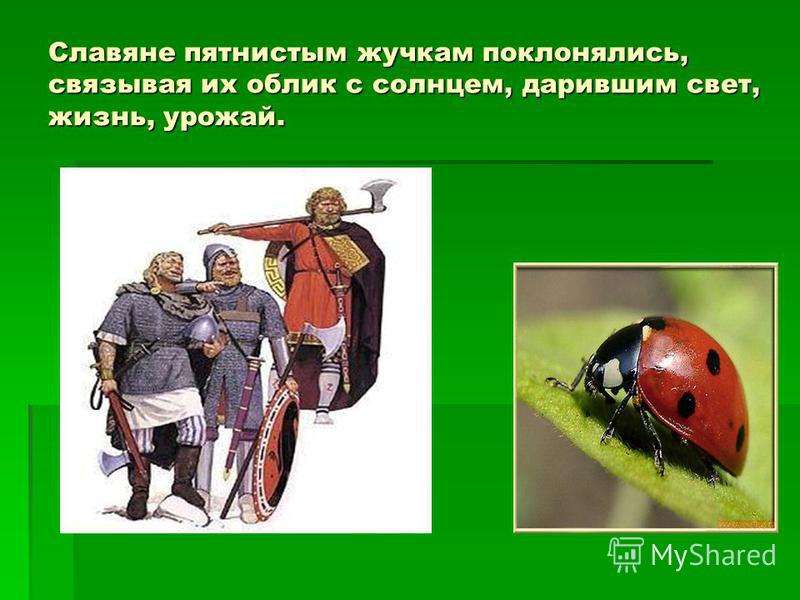
In Russia, children from time immemorial love ladybirds. In childhood, if a ladybug sat on our hands, we told her a poem: "Ladybug, fly to heaven, Bring us bread, Black, white, Just not burnt." She listened attentively, and we threw her to the sky. And the continuation of the poem is: “Ladybug, Fly to heaven - I will give you bread! Ladybug, Fly to heaven, There your children Eat candy - All one by one, And not one for you! "" Ladybug, fly to heaven, Bring us bread, Black, white, Just not burnt. " She listened attentively, and we threw her to the sky. And the continuation of the poem is: “Ladybug, Fly to heaven - I will give you bread! Ladybug, Fly to heaven, There your children Eat sweets - All one by one, And you no one! "
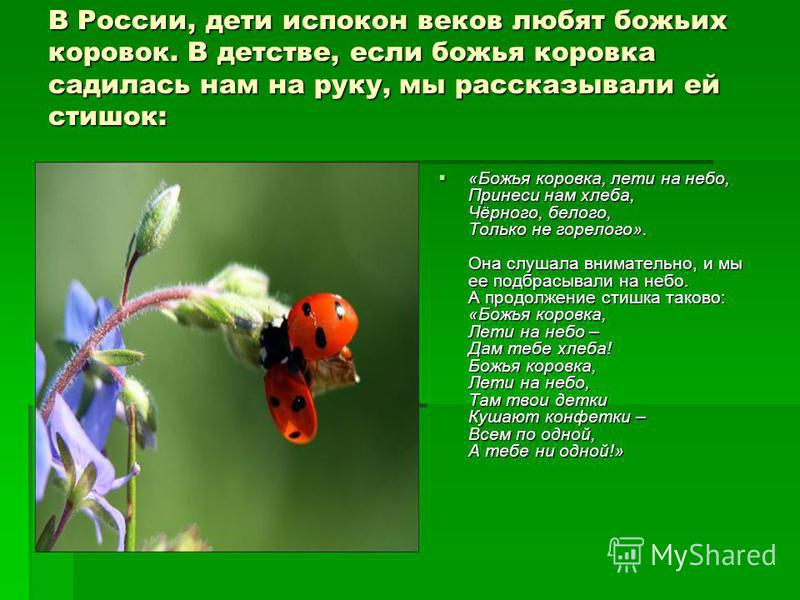
In Russia, traditionally they turned to the cow with the question: “Ladybird, will there be a bucket tomorrow?” If she flew away, it means that the weather will be fine, if not, it will rain. The Slavs "wondered" with the help of a ladybird, asking: "Ladybird, should I live, should I die or fly to heaven?" In Russia, traditionally they turned to the cow with the question: “Ladybird, will there be a bucket tomorrow?” If she flew away, it means that the weather will be fine, if not, it will rain. The Slavs "wondered" with the help of a ladybird, asking: "Ladybird, should I live, should I die or fly to heaven?"
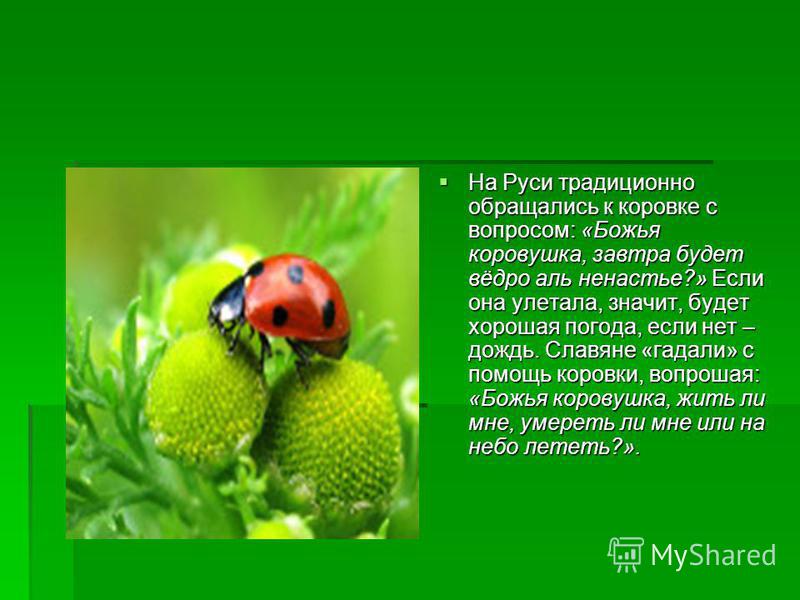
Legend of Ladybug: The image of a ladybug is found in a number of East Slavic myths. According to one of them, the wife of the god of thunder Perun was turned into a ladybird, thus punished for treason. Seduced by the serpent-tempter, Perynya fled with him, leaving the children. Perun scorched her with lightning, and since then on her wings you can see seven spots by the number of children left in the sky. The image of a ladybug is found in a number of East Slavic myths. According to one of them, the wife of the god of thunder Perun was turned into a ladybird, thus punished for treason. Seduced by the serpent-tempter, Perynya fled with him, leaving the children. Perun scorched her with lightning, and since then on her wings you can see seven spots by the number of children left in the sky. East Slavic myths serpent East Slavic myths serpent

The name of this insect is associated with the belief that the ladybird belongs to Perun’s flock of heaven. It mediates the connection between heaven and earth, between the powerful god and people. Therefore, she was credited with magical power, the ability to influence the weather. People tried not to kill the ladybirds, so as not to incur God's wrath. The name of this insect is associated with the belief that the ladybird belongs to Perun’s flock of heaven. It mediates the connection between heaven and earth, between the powerful god and people. Therefore, she was credited with magical power, the ability to influence the weather. People tried not to kill the ladybirds, so as not to incur God's wrath.

Do you know ... Many people believe that by the number of points on the back of a ladybug you can determine its age. This is not true. There are a huge number of different ladybirds in the world, and the number of points on their wings depends on the species. They can be from two to twenty six. Many believe that the number of points on the back of a ladybug can determine its age. This is not true. There are a huge number of different ladybirds in the world, and the number of points on their wings depends on the species. They can be from two to twenty six.

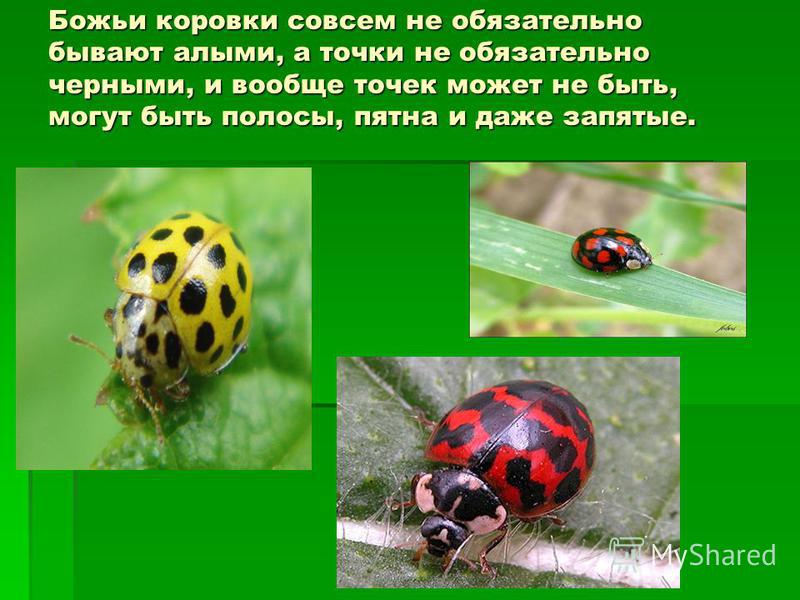
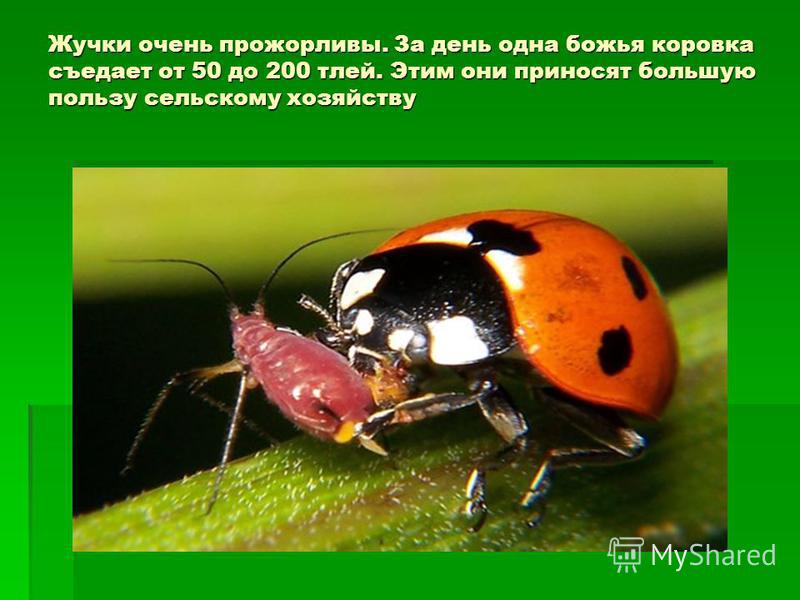

THREE LIVES OF GOD DOES Yellow shiny eggs are glued in heaps on the bottom of the leaves. Inside the testicle, you can see a small larva. She fidgets, fumbles there - wants to get out. Yellow shiny eggs glued in heaps on the bottom of the leaves. Inside the testicle, you can see a small larva. She fidgets, fumbles there - wants to get out.
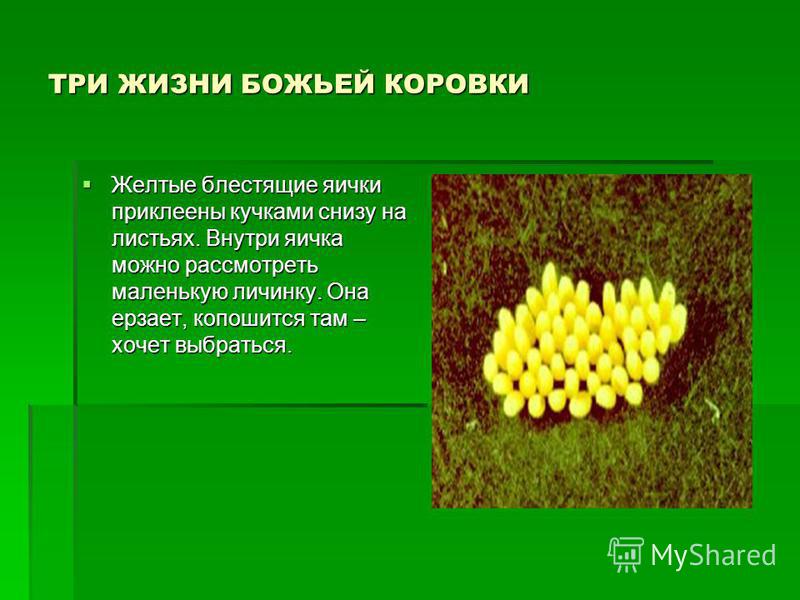
So begins the first life of a ladybug. Finally, the testicle bursts. The larva begins to crawl out of it: first her head protrudes, then her chest, then her legs. Finally, the testicle bursts. The larva begins to crawl out of it: first her head protrudes, then her chest, then her legs. But not so easy to get out of the egg! It will take a long time before the larva, then resting, then working hard again, to completely free itself. But not so easy to get out of the egg! It will take a long time before the larva, then resting, then working hard again, to completely free itself.

After three weeks, the larva hangs upside down and freezes. Hanging day, another ... After three weeks, the larva hangs upside down and freezes. Hanging day, another ... Then the skin on her back bursts, begins to creep up, going to harmonica. And a thick, milky white pupa becomes visible. Then the skin on her back bursts, begins to creep up, gathering like an accordion. And a thick, milky white pupa becomes visible.

THE SECOND LIFE OF A GOD-COW It's a strange, this second life. Without traveling through the bushes, through grass, without hunting exploits. Hanging, simple hanging in a secluded place. Weekly or two week. Outside, the pupa darkens and becomes covered with yellow, orange, black spots. And inside ... A bug is born inside. At the ladybug the THIRD LIFE has begun! Strange it, this second life. Without traveling through the bushes, through grass, without hunting exploits. Hanging, simple hanging in a secluded place. Weekly or two week. Outside, the pupa darkens and becomes covered with yellow, orange, black spots. And inside ... A bug is born inside. At the ladybug the THIRD LIFE has begun!
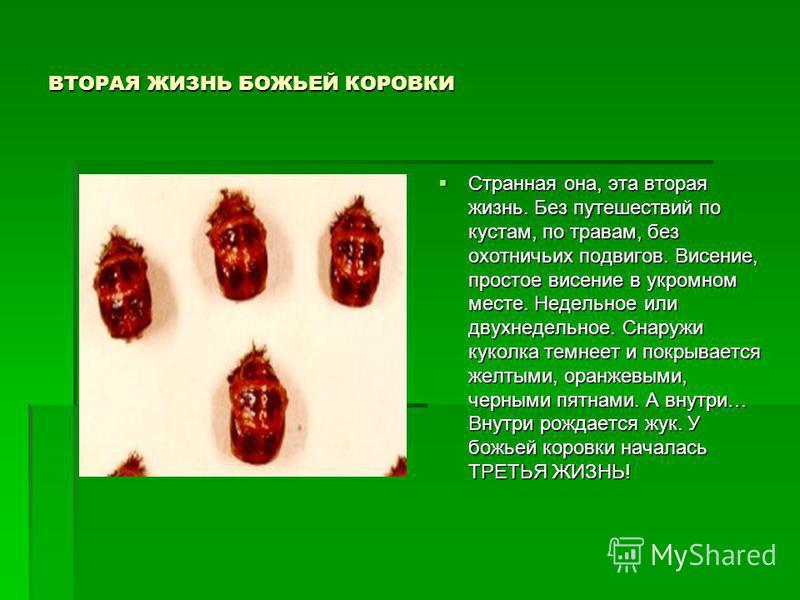

This is interesting: The origin of the name "cow" is most likely due to the biological peculiarity of the bug: it can produce milk, and not ordinary, but redder! Such a liquid is released in case of danger from the pores on the folds of the limbs. Milk is extremely unpleasant to taste (and in large doses even deadly!) And scares off predators. The origin of the name "cow" is most likely due to the biological feature of the bug: it can produce milk, and not ordinary, but reddish! Such a liquid is released in case of danger from the pores on the folds of the limbs. Milk is extremely unpleasant to the taste (and in large doses, even deadly!) And scares off predators,

Ladybirds overwinter under stones, low bushes, in fallen leaves on the forest edges. For the winter bugs gather in large clusters. Ladybirds overwinter under stones, low bushes, in fallen leaves on the forest edges. For the winter bugs gather in large clusters.

WATCH THE GOD BABY WATCH THE GOD BABY 1. Find the ladybugs in the country, in the forest. Count how many points they have on the wings. Determine the name of the ladybug. Seek out yellow, brown, black ladybugs and draw them. Catch is not necessary. 2. Plant a ladybird on your hand, see how it releases droplets of caustic blood, pay attention to the sharp smell of blood. After this experience, let go of the beetle. 3. Observe how a ladybug hunts for aphids, how long does it look for prey? Is it easy to handle aphids? 4. In the beginning of summer, locate the larvae of the ladybirds. Remember them well, and always treat them carefully. 1. Find the ladybirds in the country, in the forest. Count how many points they have on the wings. Determine the name of the ladybug. Seek out yellow, brown, black ladybugs and draw them. Catch is not necessary. 2. Plant a ladybird on your hand, see how it releases droplets of caustic blood, pay attention to the sharp smell of blood. After this experience, let go of the beetle. 3. Observe how a ladybug hunts for aphids, how long does it look for prey? Is it easy to handle aphids? 4. In the beginning of summer, locate the larvae of the ladybirds. Remember them well, and always treat them carefully.
With this book you will learn about the most daring flowers, the first to meet spring, you will meet with ants, butterflies and ladybugs, you will understand what the strength and bravery of the oak tree, get into the kingdom of mushrooms and lichens, penetrate into the secrets of bats, get acquainted with life " King of Rodents "- beaver. This book is for younger students, but it will be interesting to both parents and teachers, who together with the child will want to meet with the unique world of wildlife.
Bird buckwheat.
When I was small, this weed always puzzled me. I met her both on the road, and on the waste ground, and on the bank of the river, but it grew especially thick on our impassable, completely rustic-looking street. The big mound right in front of the house was completely green from this grass.
She puzzled me because, no matter who I asked, no one knew her name. Wormwood, motherwort, yarrow - all these herbs were known to me. But this, the most ordinary ...
“Herbal grass is called,” said grandmother. “It's among the people.” And as scientists dubbed, I do not know.
I “studied” the mysterious grass with the greatest attention. I found out that the root of her is rather thin and weak, but the stems are strong, resilient, and, however much we walked along our mound, she did not disappear from it. The leaves are small, and the flowers are tiny and sit at the very stem, as if hiding under the protection of the leaves.
Geese always grazed on the hill. I didn’t like it when they pulled their necks and hissed, so I didn’t come close to them. But I saw that they eat my mysterious weed, and they eat with enviable appetite.
WITH possession
Green pages of the book of nature
Page one, which tells about the grass at our house
Bird buckwheat
From the life of dandelions
Yarrow
Sour but tasty
Burdock, he's burdock
The most bitter grass
Green traveler
Wasteland resident
Make friends with nettles
The second page, where we are talking about the first flowers that meet spring
The bravest
Giving honey
Hurried crested
Anemone
Cheerful, fresh, washed
Goose bow
Grass casting dreams
Keys to summer
Page three, written with the hope that flowers will always bloom on earth
Page four - about trees
About birch and birch sap
Strength and weakness of oak
City tree
Bold tree
Page five, whose heroes are mosses
Below the grass
From the Arctic to Antarctica
Where does the moss begin
Live sponge
Kukushkin flax, ostrich feather and others
Page six - about mushrooms
Not plants or animals
Why should mushrooms in the forest
His Majesty Borovik
Insidious doubles
Wolf tobacco, hare potatoes
Going for mushrooms
Page seventh, almost fabulous, which invites you to lichens
Costume forest king
Nakipny, leafy, bushy
Union of fungus and algae
Reindeer moss
Long-livers
Lichens are leaving the city
Page Eight, the events of which occur in the spider kingdom
Page Nine, on the complex relationship of man and insects
Page ten on dragonflies
Just
Big-eyed hunters
Life under water
Dragonflies waiting for help
Page eleven, whose heroes are the golden-eyed, they are also flornitsy
First meeting
Egg on a thin stalk
"Lions" and running pupa
Defenseless beauties
Page twelve - about beetles
Who more than anyone in the world
May beetle and its relatives
Beetle on the road
Talking beetle
Six-legged deer
Big water lover
Without them, the earth would be bored
Page thirteen, almost detective - about a dangerous criminal among insects
Verbal portrait
His first "case"
He crosses all boundaries
He changes clothes
He is hiding
Who will win?
Page fourteen, where we are talking about the extraordinary life of an ordinary ladybug
"Sun"
Name on the wings
Three Life Ladybird
Deceptive appearance
Migratory ... bugs
Where cows overwinter
Trouble
Page fifteen, the most colorful, because it tells about butterflies
140 thousand species
Pollen on motley wings
How many legs does a caterpillar have?
Unusual Duty
Admiral's Dangerous Life
Bluebird in an anthill
Mysterious hawk moths
Dim Rainbow
Page Sixteenth, which tells how insects hibernate
Page seventeen, the heroes of which are insects, and the time of action is spring
First butterflies
Hooray! Woke up the flies!
Take care of the bumblebees!
Ants that everyone remembers
Page Eighteenth, about frogs and toads, which many do not like at all
Their trouble is our fault
What are frogs and toads
Similar but different
Link in the indissoluble chain
Page nineteenth, about the life of birds in the fall
Where, how and when?
And who remains?
Help the birds!
Page Twenty, about those birds that stay with us in the winter
Crossbones
Tap dance
Bullfinch
Woodpeckers
Pussy
Kinglet
Page twenty first - about birds in spring
Starlings flew in
Singing in the blue sky
"Roscherk" chaffinch
Song thrush
Pied flycatcher
Invisible
Page twenty-two, which tells about the winter life of animals
City under the snow
Dexterous predators
Three hundred cones for lunch
White and hare
Fox hunting
About boar and elk
Page twenty-three, the most mysterious because its heroes are bats
What do the legends say
What does science say
Caught an echo
Forest ambulance
Like birds and with birds
Do not hurt winged animals!
Page Twenty-Four, which tells about the "King of Rodents"
"King of rodents"
Miracle first - beaver teeth
Miracle Two - beaver coat
Miracle the third - beaver tail
The fourth and fifth miracles - beaver huts and dams
The sixth miracle - beavers
One hundred squirrels for beaver
The seventh wonder - the beavers are back!
How many pages in the book of nature.